 |
||
|
||
| ||
By Maxim Liadov
The MegaWorks 510D is a new top model in the Creative's computer acoustic line. The Ispire 5700 system which occupied this place for half a year is just a slightly modernized version of the older DTT3500. The Inspire 5700 got a different appearance of the speakers, a different design of the subwoofer and it received DTS hardware decoding support. But the sound was at the same level. Besides, many wondered why they used with PC a hardware DolbyDigital/DTS decoder instead of a program DVD player (WinDVD, PowerDVD) which did can decode a multichannel DolbyDigital/DTS signal. The decoder chip, however, doesn't cost much and a user of the Creative DTT3500/Ispire5700 pays rather for convenient management of the system with a remote control and an amplifying and decoding unit. And at the same time, the subwoofer is entirely used to form basses instead of being used by an amplifying unit, which is often a drawback of many systems lacking a decoder. Well, the MegaWorks 510D 5.1 system lacks for a decoder typical of Creative, but it still has a multichannel digital-in (a 4-pin minijack) and an internal 6-channel DAC. That is why 510 means that this is a 5.1 system and D stands for digital. Creative also has a MegaWorks 210D system which, thus, is a 2.1 acoustic system with a digital input. At the same time, the MegaWorks 510D can be connected by three analog cables: for front, rear and center/sub channels. This may be useful when you connect a 6-channel card not from Creative or a separate DolbyDigital/DTS decoder (or a DVD player with a built-in decoder). Besides, it's also possible to connect 4-channel and stereo sound sources. AppearanceThe system consists of 5 identical plastic satellites (the central speaker differs only in a design of the support) and a huge cubic wooden subwoofer. The satellites measure 108 x 160 x 143 mm and the subwoofer is 325 x 290 x 305 mm. Each satellite weighs about 0.5 kg and the subwoofer is 9 kg. The subwoofer stands on soft rubber legs and the satellites have removable supports also with rubber legs. This system looks actually much more impressive than previous ones!
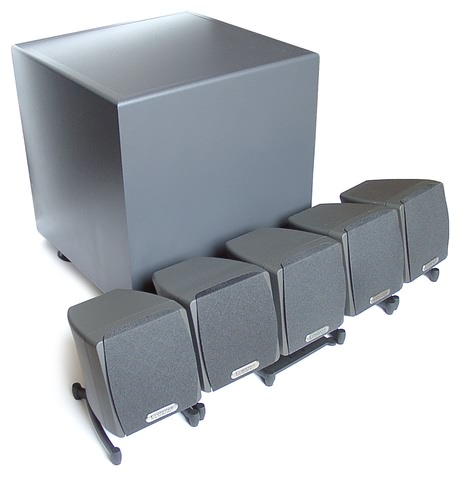 General view of the Creative MegaWorks 510D Let's compare the satellites with those from another set.
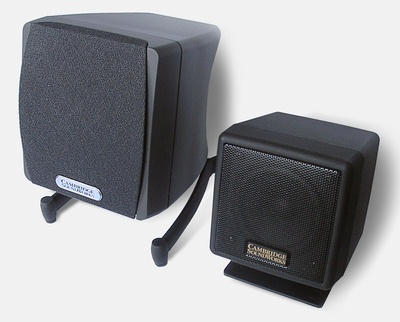 Creative MegaWorks 510D satellite (left)
While the Inspire 5700 has just a different design as compared with the DTT3500, all speakers of the MegaWorks 510D have a bigger loudspeaker. It can be compared only to the central speaker of the DTT3500/ Inspire 5700.
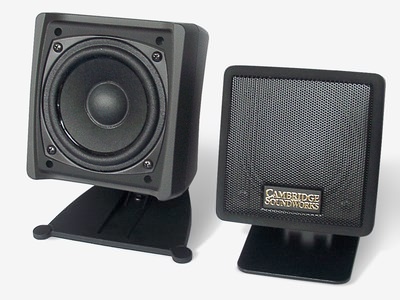 Central speaker of Creative MegaWorks 510D (without a protective grill, left) against that of Creative DTT3500 (right) The central speaker can be glued to the upper surface of the monitor or just put on the table in front of it. In both cases you can use special self-gumming stickers. Besides, the speaker is hinged so that you can bend it up or down.
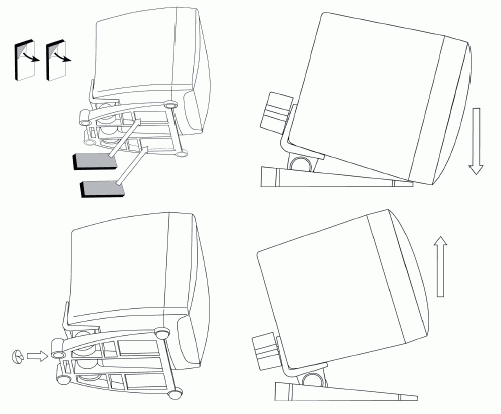 Self-gumming stickers for placing the central speaker on the monitor or in front of it There are also all necessary details to attach the speakers to the wall. Apart from the speakers there is a wired remote control and all necessary cables, as well as a a cable with a 4-pin minijack on both ends for Creative cards. Remember that the Live!5.1/Audigy cards, unlike its competitors, have a 3-channel digital-out which allows transferring digital information to all 6 speakers in a digital mode without compression.
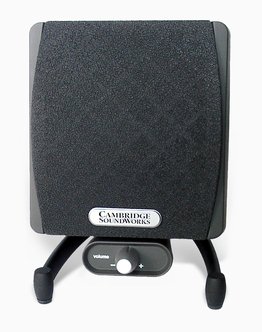 Wired remote control attached under the satellite The rear satellites have no supports, Creative says that "Accessories sold separately". Technical characteristicsThe company's site show the following characteristics (Creative MegaWorks 510D):
The Inspire 5700 and DTT3500 systems have the total power of 6 speakers of 58W RMS. The user manual and the package explain that the specification indicates characteristics of the amplifier, not the speakers. 60 W RMS x 5 channels at less than 0.1% of THD at 1kHz. 150W is generated by the subwoofer's amplifier at less than 0.3% of distortions at 100 Hz. The SNR of 95 dB is given for the amplification part of both analog and digital signals. It's also interesting, that the more expensive the speakers, the narrow the frequency range (i.e. the more conscious the manufacturer :). The cheapest Chinese speakers usually "have" 20 Hz - 20 kHz (don't only think the AFC is flat and smooth). That is why I recommend that you don't pay much attention to the characteristics indicated by the manufacturer. SatellitesAccording to the company, for the MegaWorks line they used technologies and components of the more expensive acoustic system of the Newton series, including a hybrid amplification section with the mysterious B.A.S.H. technology, a powerful 8" (20 cm) subwoofer's loudspeaker with a big travel, high-quality 3.5" (9 cm) loudspeakers with neodymium magnets, and each satellite uses a 4-element equalizing chain. Let's disassemble the speaker:
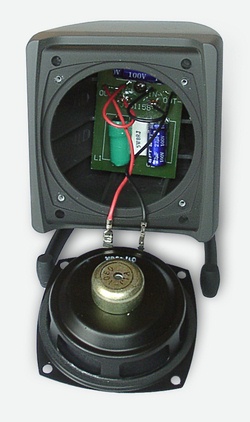 Satellite of the Creative MegaWorks 510D (disassembled) Inside is a card with unsoldered elements: 2 capacitors, a inductor and a resistor. The cabinet is filled up with sound-absorbing material to eliminate all additional parasitic sounds inside the satellite. AFC of the satellitesAt last the industry of computer multimedia devices has made a solid step forward. Along with praising words of fantastic sound improvement there are realistic explanations of advantages of one speaker in comparison to another. So, to prove that the acoustic field of the satellites is uniform the picture on a package displays how amplitude depend on frequency in two positions: on the loudspeaker's axis and at a certain angle. As you can see, the AFCs coincide in the most considerable frequency range. And the flatness is acceptable - 7 dB (in the mid range it's even less). Below are two more figures for some BRAND B SAT and BRAND C SAT speakers. Their graphs are less smooth and they have different timbre coloration in different positions of a user.
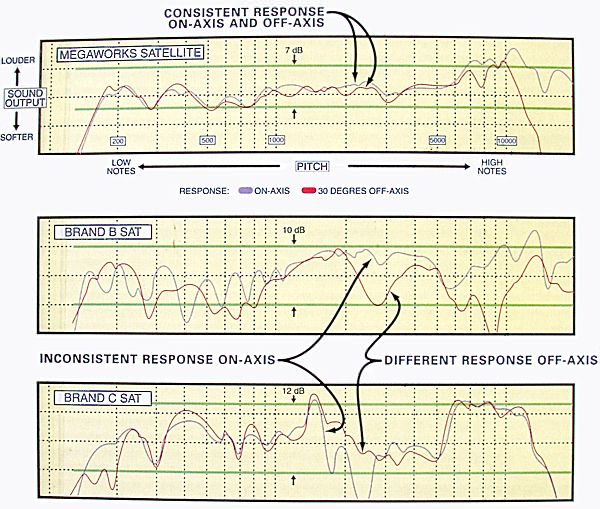 AFC of the MegaWorks 510D satellites (by Creative) in comparison to other brand speakers So we decided to check it. The RMAA AE program, a professional EgoSys Waveterminal sound card with an ideal AFC and a Behringer ECM8000 measuring microphone were our tools. The measurements were carried out in a half-dead room (not in a special anechoic chamber), but thus the results are closer to the reality.
 AFC of the Creative MegaWorks 510D satellites on the loudspeaker's axis and at 30 degrees The tests show the same results: the AFC keeps within 7 dB, and the graphs almost coincide (sensitivity of a human ear for the volume level is at 1 dB). Remember that an AFC of an acoustic system is a necessary but not sufficient parameter of sound. It defines an amplitude transfer linearity depending on a signal's frequency and is plotted in a logarithmic scale on both axes which corresponds to human auditory sensations in a linear proportion. An AFC with a badly broken graph is very unpleasant for a human ear. An ideal characteristic would be an even horizontal line from 20-30 Hz to 18-20 kHz with a deviation from the average not more than +/- 3 dB. The speaker with a bad AFC can't deliver a frequency range correctly. AmplifierUtilization of digital-ins and internal DACs can be justified if converters are located outside the PC case and if higher-quality converters are used in a more expensive system. Converters of multimedia sound cards of even the most expensive line of Audigy are not too far ahead of their competitors. I suspect that the sound of the front channel of the high-quality Philips UDA1328T 24/96 DAC is damaged by the operational amplifier for headphones and by the added analog signal coming from the noisy Creative CT1297 AC'97 codec. But if we connect the Audigy to the computer acoustic system, the sound will be excellent.
 Amplification section of the Creative MegaWorks 510D There are 3 Philips UDA1351TS 24/96 DAC chips with an integrated S/PDIF receiver and a digital filter. The converter has the following characteristics: SNR (without a signal) - 95..100 dB A, THD+N/S for 48 kHz - 85..90 dB A, for 96 kHz - 80..85 dB A. Although the characteristics are good, they are not better than those of the Audigy card. The DAC chips located inside the MegaWorks 510D are covered with earthed metallic cases (3 rectangles in the center on the photo). It makes possible to avoid parasitic pickups from other electric circuits. Unlike the previous Creative's models which had chips in the amplification section, here the amplifier is built on powerful International Rectifier IRF9530 unipolar transistors, 4 for each of 6 channels. SubwooferAlthough the subwoofer looks very similar to the Inspire 5700, it's larger and has a higher-quality loudspeaker. This time Creative put inside a more rigid rubber corrugation and a inflexible dynamic loudspeaker's cone covered with black varnish.
 Subwoofer of the Creative MegaWorks 510D
The wooden panels are 1.5 cm thick. As a base the engineers used a massive board 3 cm thick. The panels are covered with a think layer of sound-absorbing material (glass wool). The panels are well adjusted, and angles are used to make the construction more rigid.
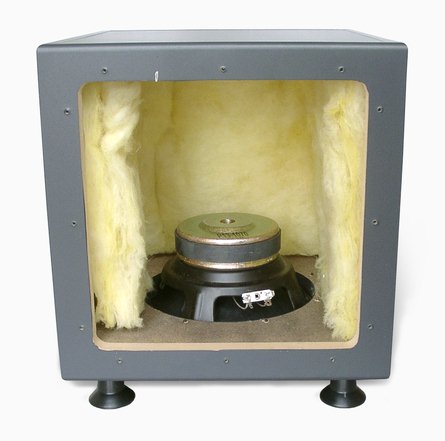 Subwoofer of the Creative MegaWorks 510D
After that we measured an AFC of the subwoofer in the operating position, i.e. standing on the floor, the loudspeaker downwards. As you can see, in the LF range the Creative MegaWorks 510D shows excellent results. The AFCs of the speakers and the subwoofer overlap each other, that is why there will be no break in the lower mid part.
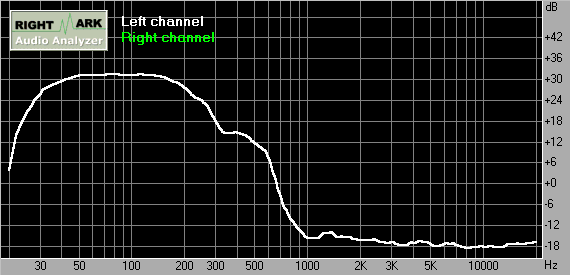 AFC of the Creative MegaWorks 510D subwoofer ConnectionThe system has a normal 6-channel analog-in based on the minijack connector. That is why you can connect any sound card - stereo, 4- or 6-channel. A signal source is automatically detected. The sub works in all modes. There is also one additional input for stereo devices (Aux).
 Rear panel of the Creative MegaWorks 510D subwoofer The digital-in has a form of a 4-pin minijack. That is why Creative do not recommend to connect sound cards different from Live!5.1 and Audigy. On the rear panel you can find an input for the wired volume control, a bass regulator for the sub (Bass +/-) and Treble Flat/Reduce. ListeningIn the tests we used a computer with the Creative Audigy sound card. And for connection we took cables from the package. Digital and analog connectionThe tests on different audio materials showed that there is no noticeable difference between the analog and digital connection. Moreover, sometimes it seemed that the Audigy played better in the analog mode. It means that the digital capabilities are just a marketing step. On the other hand, the DACs are not very expensive, that is why it doesn't make the whole construction too dear. Besides, the Creative MegaWorks 510D is a computer system, and higher-quality codecs will hardly much improve the sound which is already good enough. To check it we used a professional EgoSys Waveterminal card with the AKM 4524 I2S-codec. And it turned out that the differences from the Audigy were minimal. MusicThe tested system will be a good choice for listening to modern dance and pop music with rich bass parts. Thanks to the sub it's possible to get powerful and deep basses even if the volume level is not high. The high-quality satellites excellently deliver the whole range of middle and high frequencies, thus, creating a uniform sound field in a quite large space. The sounding is specific but it's not unpleasant. The satellites deliver the sound very accurately. The sound-absorbing material eliminates all plastic sounds completely. At a low and middle volume levels the sound doesn't seem screaming. The sub plays in synch with the satellites. MoviesThe system copes excellently with creation of sound accompaniment for DVD movies. All dialogs sound clearly. The central channel has enough power so that you can watch movies comfortably. The rear satellites can be moved away quite far without worsening the sound field. The sub is powerful enough to shake the floor with explosions and other special effects. However, I think that the system suits better for a not large room or computer corner. The matter is that at a high volume level the satellites sound too aggressively and cry a lot, the timbre changes and details get lost. If you need an acoustic system mainly for watching movies then go with big wooden 5.1 systems. GamesThe sound in games plays well. 3D shooters supporting a multichannel sound with DirectSound3D and EAX and coupled with the Live!5.1 or Audigy let you dive deep into the gaming atmosphere. The sound picture is of high quality and lacks for any distortions. The sub produces shots and explosions entirely, the sound is not overdriven. It's one of the best small systems for a computer corner. By the way, large speakers usually enable its full potential only at a middle or high volume level. This system lacks for this drawback. The best advantage of the Creative MegaWorks 510D is its 6-channel analog-in which wasn't typical of previous Creative's models that have only up to 4 ins. The competitors usually have yet less - analog and digital stereo inputs. That is why games on those systems have only a stereo sound and a subwoofer, while other speakers play only in movies. That is why it's possible to transfer only a stereo signal via a usual digital interface or the one preliminarily encoded into Dolby Digital 5.1; and it is only the NVIDIA nForce chipset which can do that in games (that means real-time lossy compression). ConclusionThe Creative MegaWorks 510D is a high-quality and excellently sounding system. All drawbacks of the previous models were corrected. The construction is entirely redesigned - from dynamic loudspeakers to insides of the amplifier, and now Creative can boast of AFCs of its speakers. As a result, the MegaWorks 510D is probably the highest-quality solution in its class. Unfortunately, its price is too high. It will hardly replace a normal acoustic set for a home theater, but it will definitely find its niche on the market. Highs:
Lows:
Write a comment below. No registration needed!
|
Platform · Video · Multimedia · Mobile · Other || About us & Privacy policy · Twitter · Facebook Copyright © Byrds Research & Publishing, Ltd., 1997–2011. All rights reserved. |